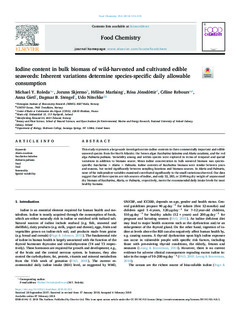| dc.contributor.author | Roleda, Michael | |
| dc.contributor.author | Skjermo, Jorunn | |
| dc.contributor.author | Marfaing, Hélène | |
| dc.contributor.author | Jonsdottir, Rosa | |
| dc.contributor.author | Rebours, Celine | |
| dc.contributor.author | Gietl, Anna | |
| dc.contributor.author | Stengel, Dagmar | |
| dc.contributor.author | Nitschke, Udo | |
| dc.date.accessioned | 2018-02-18T07:22:38Z | |
| dc.date.available | 2018-02-18T07:22:38Z | |
| dc.date.created | 2018-02-16T17:21:54Z | |
| dc.date.issued | 2018-07-18 | |
| dc.identifier.citation | Food Chemistry. 2018, 254 333-339. | nb_NO |
| dc.identifier.issn | 0308-8146 | |
| dc.identifier.uri | http://hdl.handle.net/11250/2485518 | |
| dc.description.abstract | This study represents a large-scale investigation into iodine contents in three commercially important and edible seaweed species from the North Atlantic: the brown algae Saccharina latissima and Alaria esculenta, and the red alga Palmaria palmata. Variability among and within species were explored in terms of temporal and spatial variations in addition to biomass source. Mean iodine concentration in bulk seaweed biomass was speciesspecific: Saccharina > Alaria > Palmaria. Iodine contents of Saccharina biomass were similar between years and seasons, but varied significantly between sampling locations and biomass sources. In Alaria and Palmaria, none of the independent variables examined contributed significantly to the small variations observed. Our data suggest that all three species are rich sources of iodine, and only 32, 283, or 2149 mg dry weight of unprocessed dry biomass of Saccharina, Alaria, or Palmaria, respectively, meets the recommended daily intake levels for most healthy humans. | nb_NO |
| dc.language.iso | eng | nb_NO |
| dc.relation.uri | https://www.sciencedirect.com/science/article/pii/S0308814618302498?via%3Dihub | |
| dc.rights | Attribution-NonCommercial-NoDerivatives 4.0 Internasjonal | * |
| dc.rights.uri | http://creativecommons.org/licenses/by-nc-nd/4.0/deed.no | * |
| dc.subject | Alaria esculenta | nb_NO |
| dc.subject | Saccharina latissima | nb_NO |
| dc.subject | Palmaria palmata | nb_NO |
| dc.subject | Food | nb_NO |
| dc.subject | Feed | nb_NO |
| dc.subject | Seasonality | nb_NO |
| dc.subject | Spatial variability | nb_NO |
| dc.title | Iodine content in bulk biomass of wild-harvested and cultivated edible seaweeds: Inherent variations determine species-specific daily allowable consumption | nb_NO |
| dc.type | Journal article | nb_NO |
| dc.type | Peer reviewed | nb_NO |
| dc.description.version | publishedVersion | nb_NO |
| dc.rights.holder | © 2018 The Authors. Published by Elsevier Ltd. | nb_NO |
| dc.source.pagenumber | 333-339 | nb_NO |
| dc.source.volume | 254 | nb_NO |
| dc.source.journal | Food Chemistry | nb_NO |
| dc.identifier.doi | 10.1016/j.foodchem.2018.02.024 | |
| dc.identifier.cristin | 1566135 | |
| dc.relation.project | EC/FP7/308571 | nb_NO |
| dc.relation.project | Norges forskningsråd: 244244 | nb_NO |
| cristin.unitcode | 7566,4,0,0 | |
| cristin.unitname | Marin Ressursteknologi | |
| cristin.ispublished | true | |
| cristin.fulltext | original | |
| cristin.qualitycode | 1 | |

